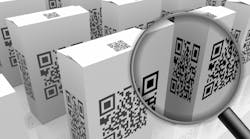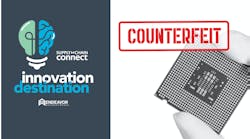Download this article in PDF format.
With realities like the global chip shortage prompting more “bad actors” to develop unapproved reproductions or copies of the real thing, the companies that make anti-counterfeit and tamper-proof packaging are continually developing new ways to combat these crimes. They play an especially critical role in the electronics sector, where one fake relay, component or chip could impact a machine’s operations and the safety of its users.
Anti-counterfeit packaging companies have a fairly large, and ever expanding, addressable market. In fact, counterfeit products are not just a passing problem, but are part of a major global industry. According to Food Engineering magazine, the global pandemic has led to an increase in the quantity of counterfeited products in many parts of the world, due to restrictions in global trade.
“This, coupled with the huge growth of the e-commerce industry in 2020,” the publication states, “has increased demand for anti-counterfeiting and brand protection solutions.”
It’s Not a New Problem
Counterfeiting isn’t a new problem, but it’s one that’s been gaining more steam as a result of the pandemic, advancements in technology and our increasingly tech-centric and “connected” world. “Counterfeiting has grown from a $30 billion trade problem in the 1980s, and now exceeds $600 billion in trade,” North Carolina State University reports. “Trade data trends suggest that this number could soon rise to over $1.8 trillion, which is more than the gross domestic product of most countries.”
NC State says total value of counterfeit and pirated goods was about $1 trillion in 2013 and is expected to grow to close to $3 trillion this year. Some of the biggest targeted markets include consumer goods, tobacco, aerospace components, electronics, pharmaceuticals, automotive parts, industrial components, apparel and food.
Is Better Packaging the Answer?
According to Polaris Market Research, the global anti-counterfeit packaging market size and share is expected to post a 12.6% compound growth rate (CAGR) and its revenue is expected to reach nearly $320 billion by 2030—up from about $120 billion last year. As it nearly triples in size, the market will be developing packaging that helps buyers and sellers avoid unauthorized replicas of the real product.
By definition, anti-counterfeiting packaging is used to secure the packaging of original products, and companies use it to reduce the risk of counterfeiting. Polaris says many different business sectors are facing counterfeiting challenges right now, and that both food and pharmaceutical industries are incorporating anti-counterfeiting packaging measures to safeguard their packaging and avoid duplication.
Other key factors influencing the adoption of anti-counterfeiting packaging measures include the growing consumer awareness of unapproved reproductions of products, economic damage to the company and consumer health risks. Increased government regulations in food and pharmaceutical packaging, as well as a rising emphasis on eliminating counterfeit goods in developing and developed economies, are also accelerating growth in this particular market.
In addition to pharmaceutical industries, anti-counterfeit packaging is also experiencing a higher demand for packaging products from food and beverage and personal care. And while counterfeiting has always challenged brands, Flexible Packaging magazine says that with e-commerce taking the lead, consumers are bombarded with the possibility of being affected.
“Governments across the globe are trying to implement strict legislations and penalties and encourage brands to use anti-counterfeit packaging,” the publication points out, “but the markets continue to be flooded with undetectable fakes.”
Counterfeiting is Big Business
With the World Customs Organization reporting that counterfeit goods generate over $650 billion in sales annually, Flexible Packaging says manufacturers are incorporating sophisticated technology into packaging to get ahead of the counterfeit industry, with some of the newest innovations being:
- Radio frequency identification tags (RFIDs) equipped with microchips
- Security seals
- Barcodes
- Security ink and printing
- Smart labels and holograms
- Mass encoding
- Digital encryption and serialization
Citing some real-world examples of these technologies in action, Flexible Packaging says Snapdragon has developed “Swoop technology” that’s capable of detecting counterfeit products in real-time and removing the links across online platforms. Applied DNA Sciences invented “Encrypted Optical Markers for Security Applications” and Hitachi Construction Machinery adopted Toppan Printing’s ID-NEX. The latter is a cloud-based service with smartphone authentication that uses a hologram to facilitate authentication and traceability.








